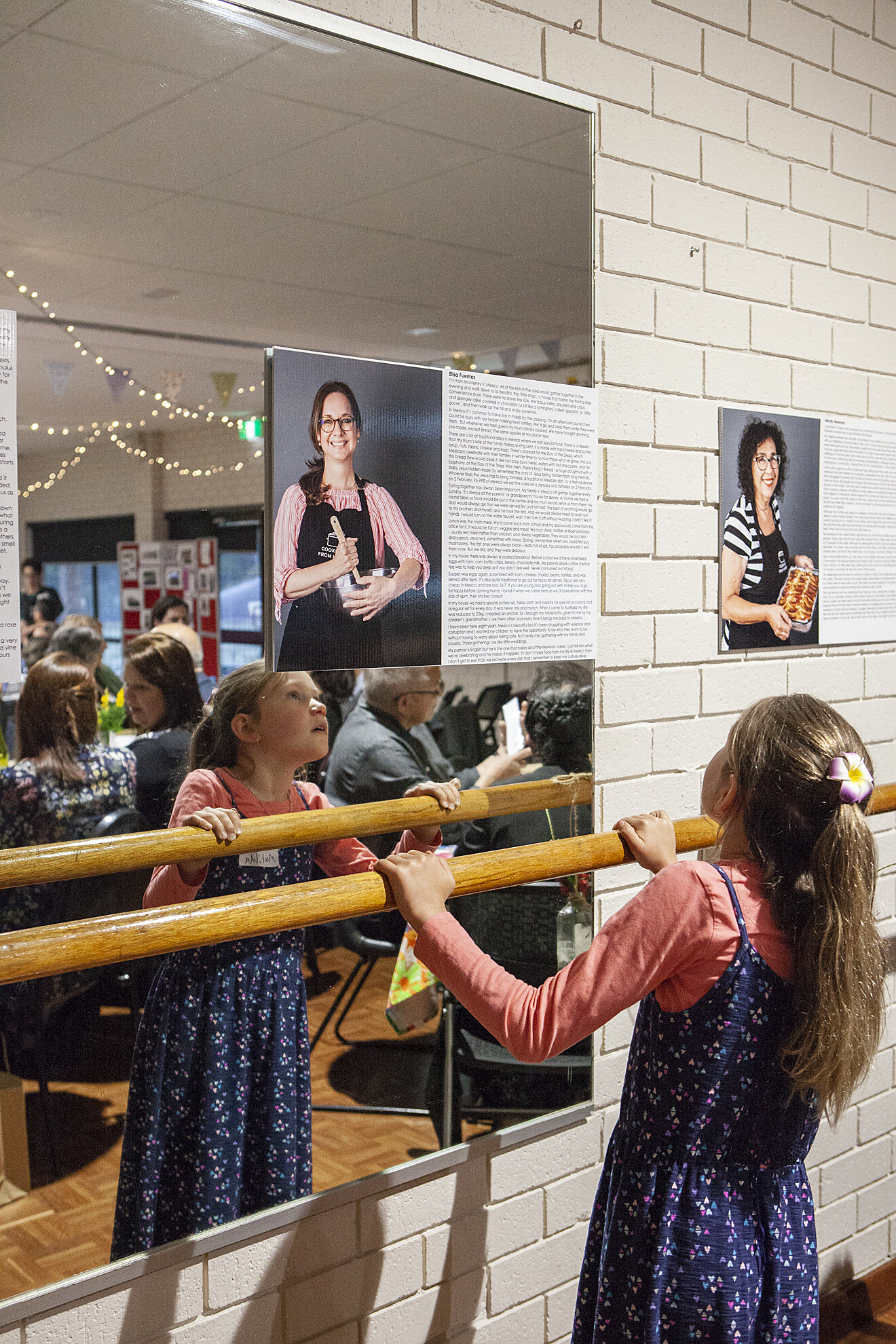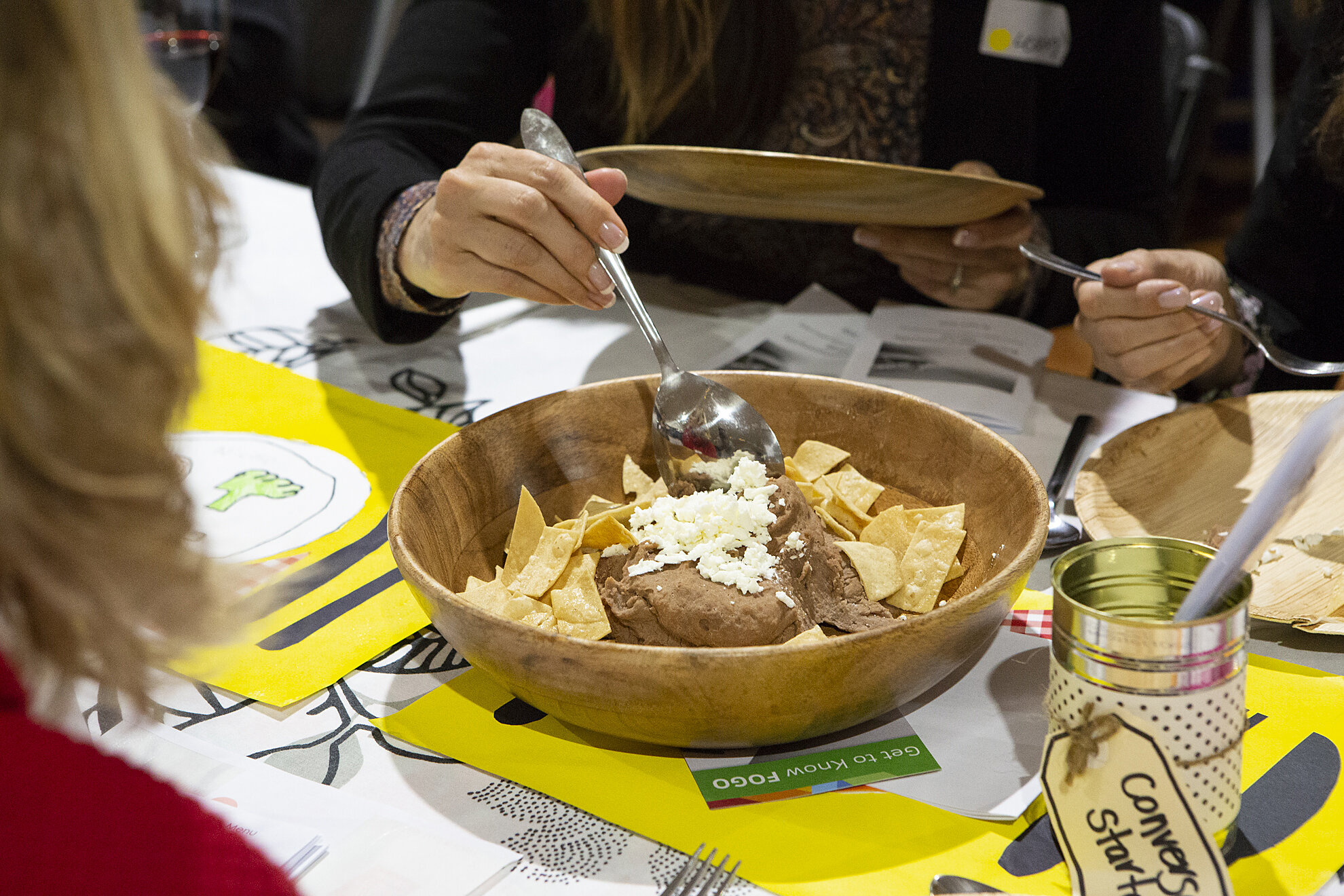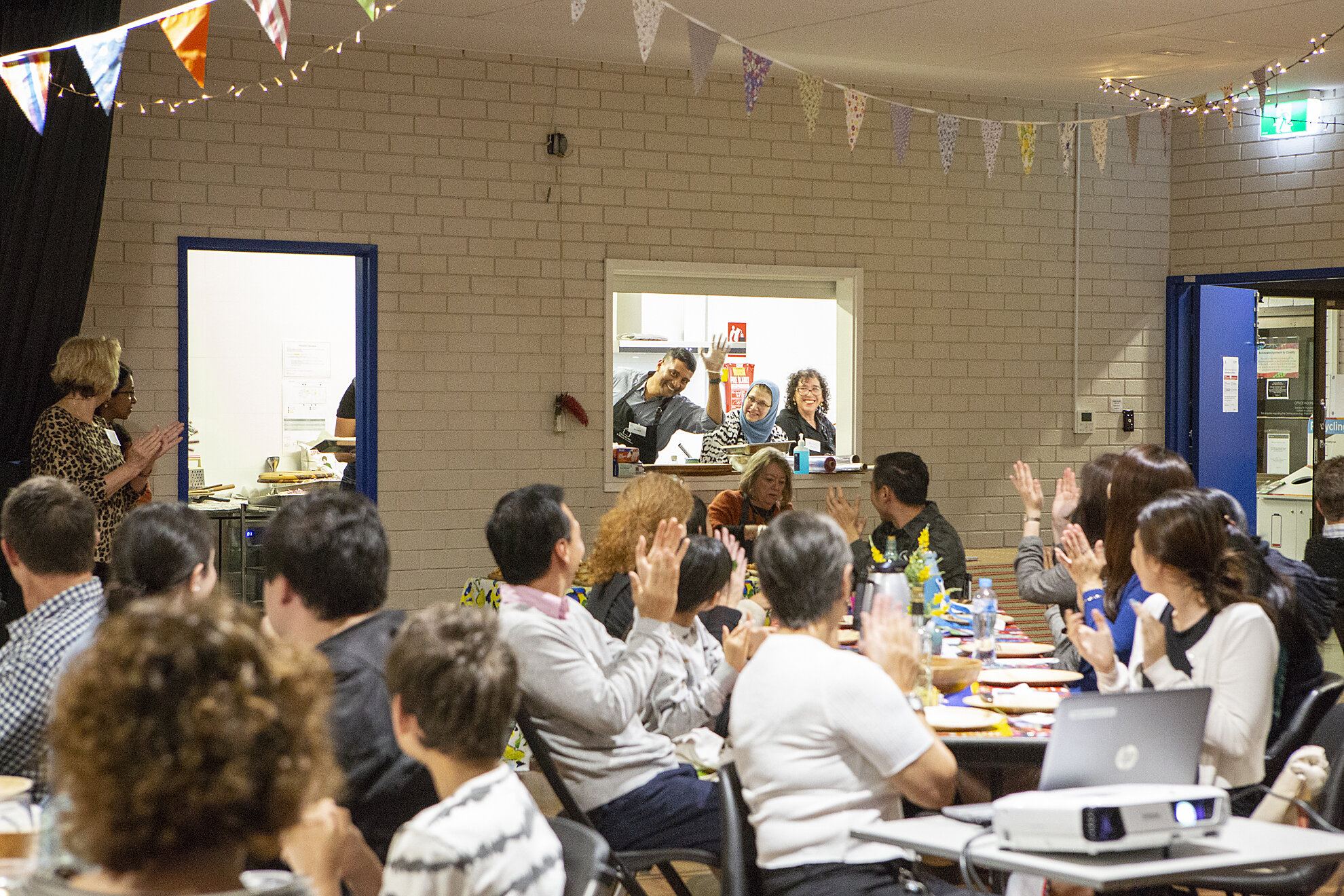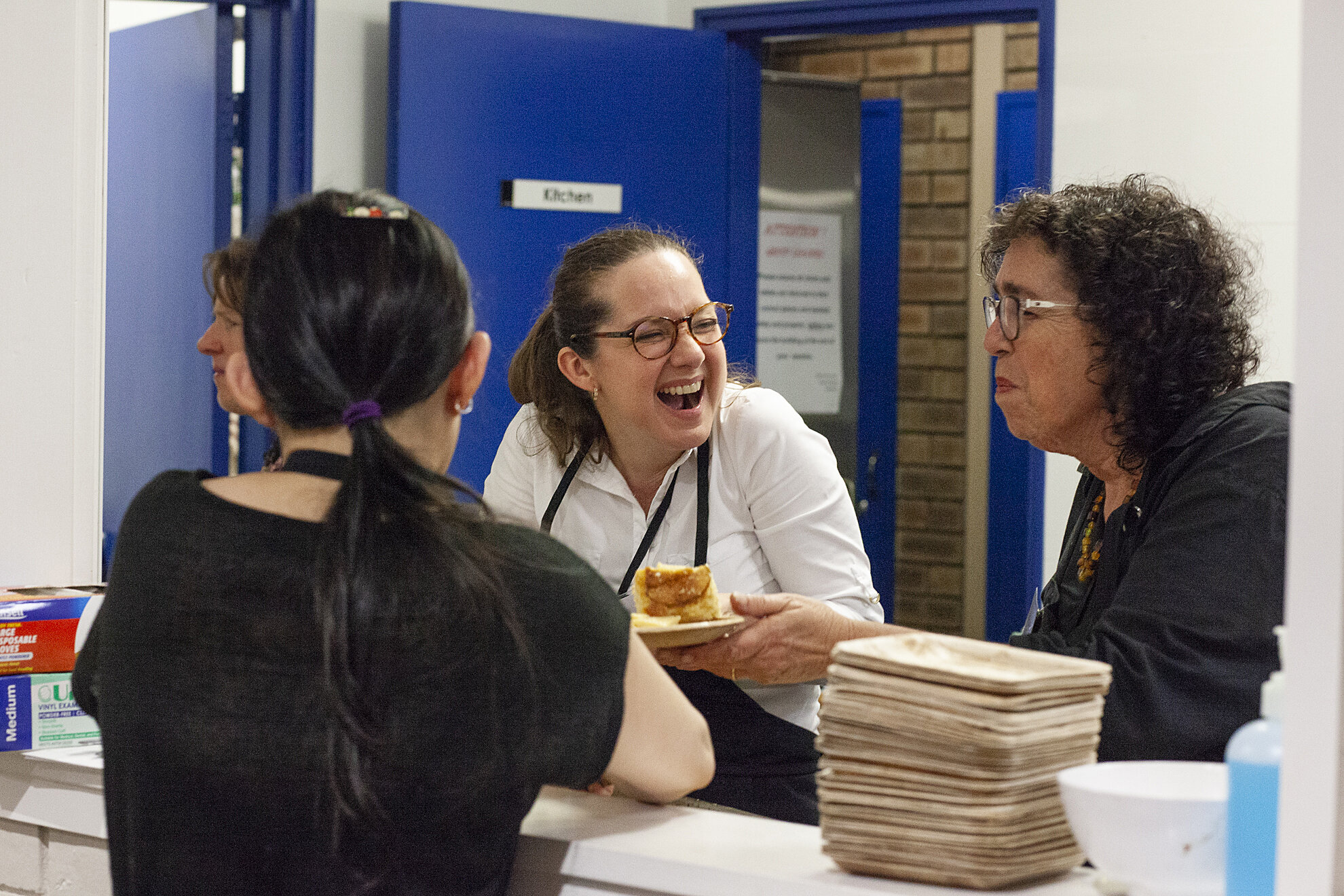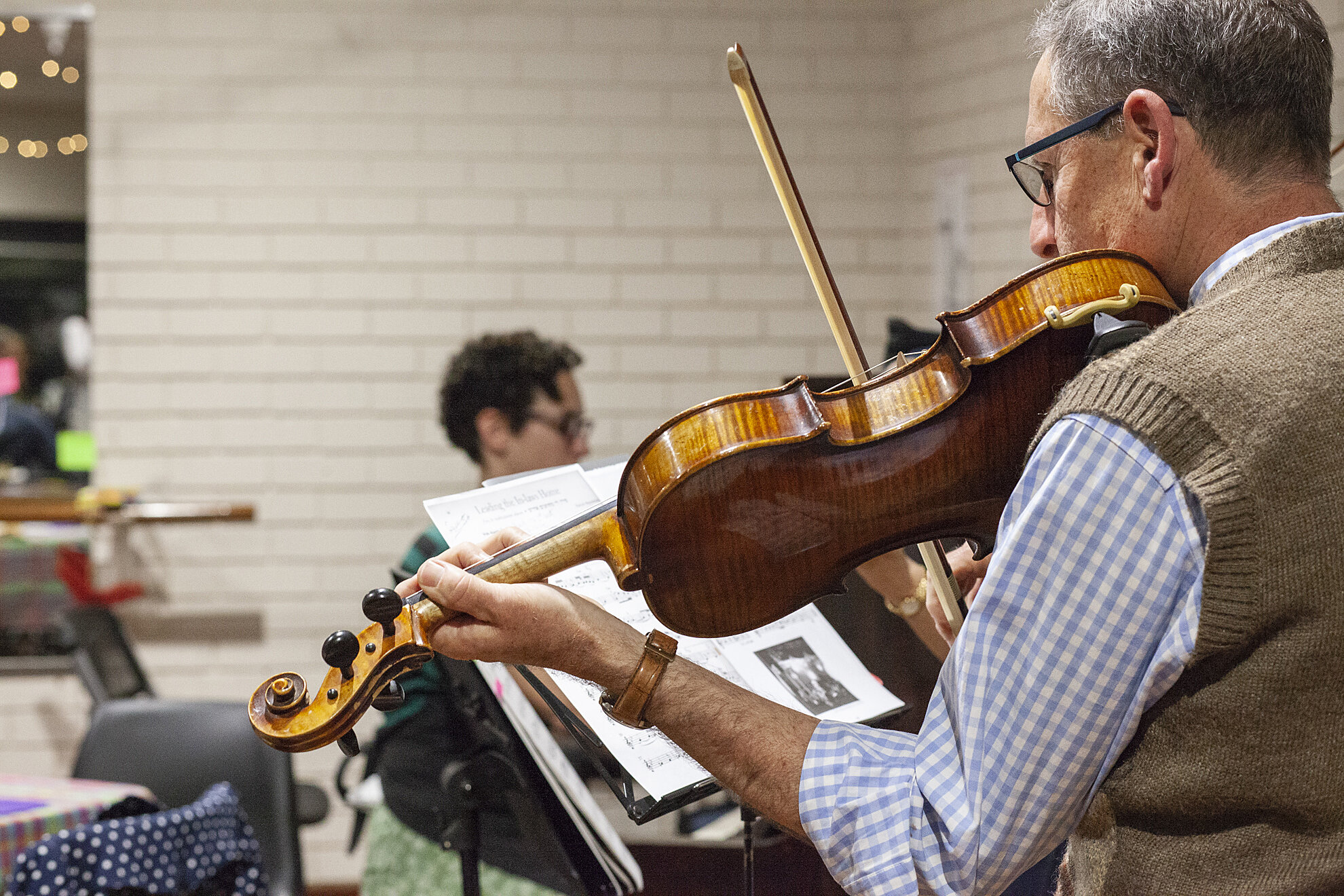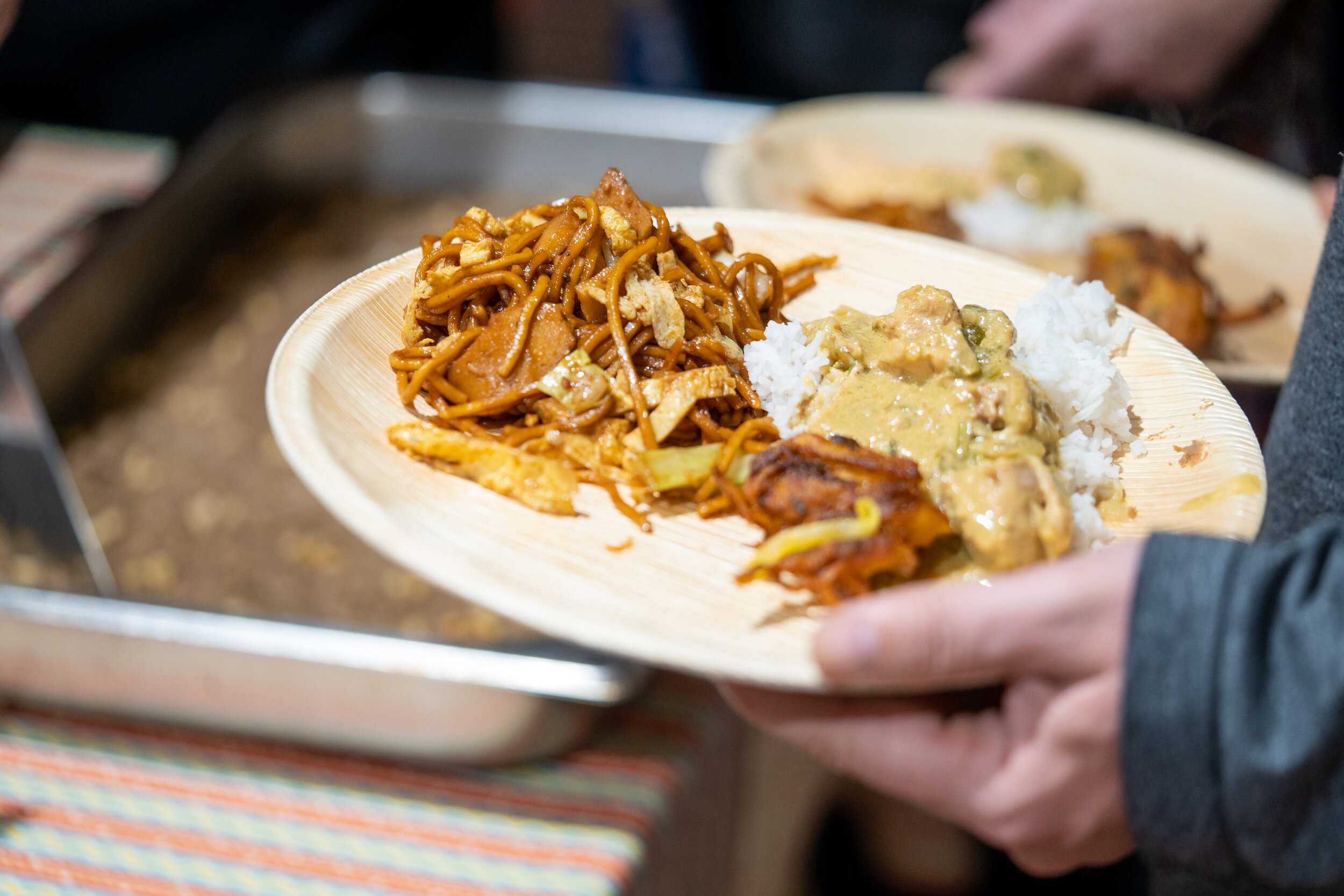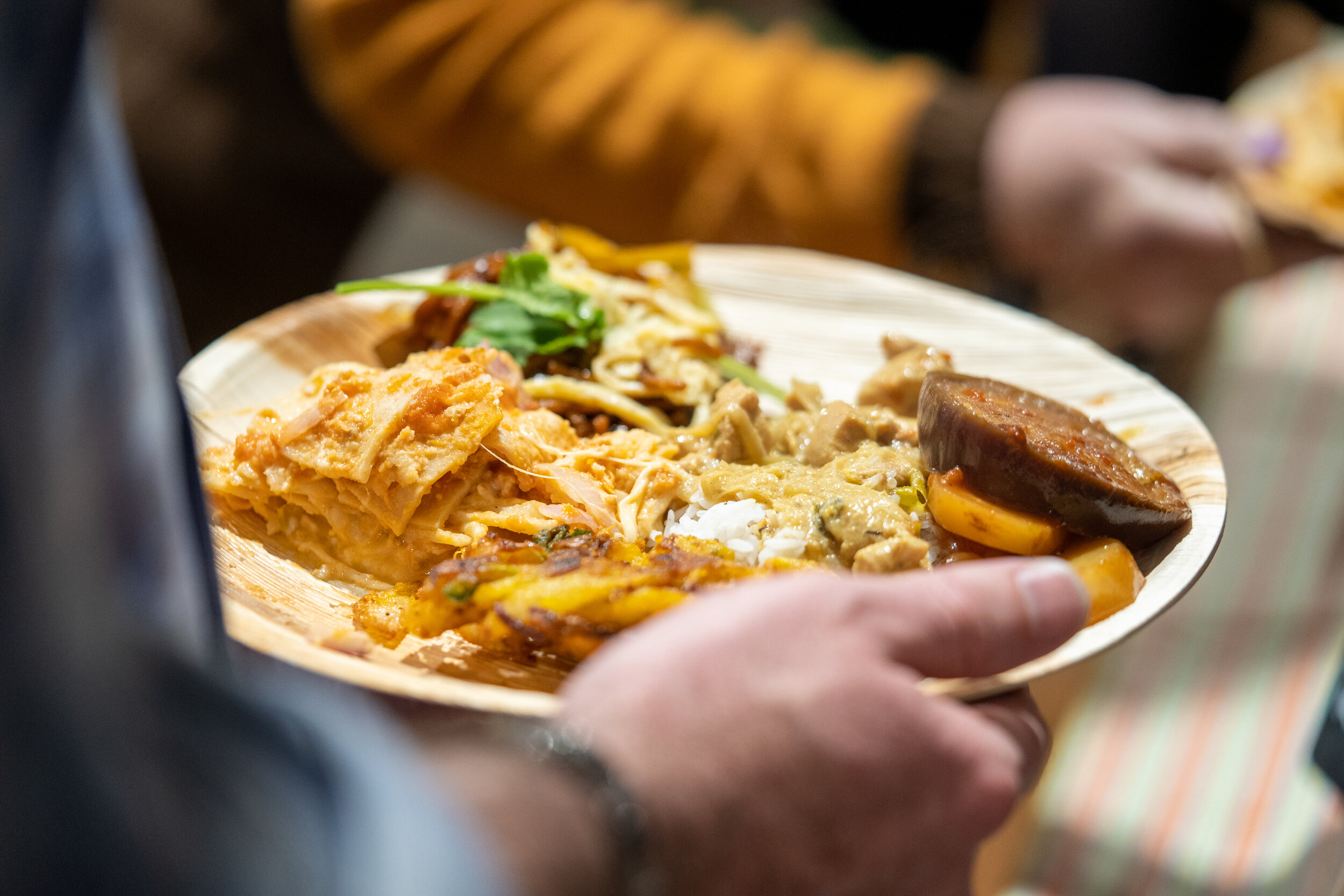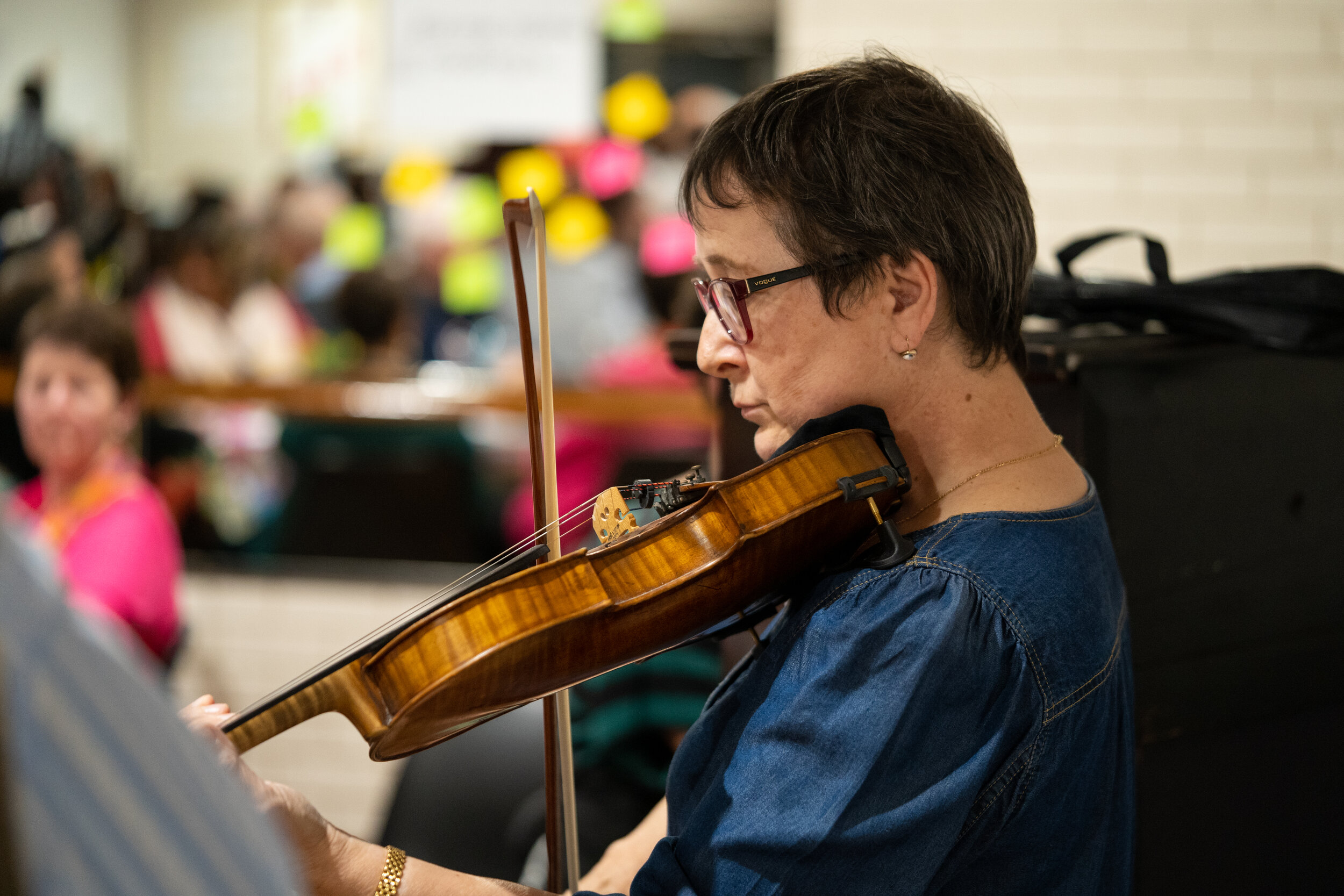Home cooks from Ashkenazi Jewish origin, India, Mexico, Malaysia and Lebanon offered up incredible food at a sell out dinner.
Before serving the dishes, our home cooks introduced each one through this film.
Meet the cooks involved!
I’m from Monterrey in Mexico. All of the kids in the area would gather together in the evening and walk down to la tiendita, the ‘little shop’, a house that had in the front a little convenience store. There were no stores like IGA. We’d buy lollies, chicklets and chips, and spongey cake covered in chocolate (a bit like a lamington) called ‘gansitos’ or ‘little goose’, and then walk up the hill and enjoy ourselves.
In Mexico it’s common to have live in maids for the cooking. On an afternoon our kitchen could be busy with our helper making fresh tortillas. We’d go and steal them while they were fresh. But whenever we had guests my mum always cooked. We never bought anything pre-made, except bread. The same applies at my place now.
There are a lot of traditional days in Mexico where we eat special food. There is a dessert that my mum’s side of the family makes during Lent. It is made with hard bread and butter, syrup, nuts, raisins, cheese and eggs. There’s a bread for the Day of the Dead, which Mexicans celebrate with their families in winter time to honour those who’ve gone. We buy this bread (few would cook it, like hot cross buns here), eaten with hot chocolate. And for Epiphany, or the Day of the Three Wise Men, there’s King’s Bread - a huge doughnut with a baby Jesus hidden inside (to remember the story of Jesus being hidden from King Herrod). Whoever finds the Jesus has to bring tamales, a traditional Mexican dish, to a festival dinner on 2 February. 95-99% of Mexico will eat the cake on 6 January and tamales on 2 February.
Eating together has always been important. My family in Mexico still gather together every Sunday. It’s always at the parents’ or grandparents’ house for dinner. At home we had a round table so food would be put in the centre and my mum would serve us from there. My dad would always ask that we were served first and him last. The best of anything would go to my brothers and myself, and he took the rest. And we would always need to wash our hands. I would turn on the water faucet, wait, then turn it off without washing. I didn’t like it!
Lunch was the main meal. We’d come back from school and my dad would come from the office for it. It would be full on; veggies and meat. We had steak, tortillas or beef schnitzels - usually red meat rather than chicken, and always vegetables. They would be zucchini and carrots, steamed, sometimes with mayo. Boring. I remember when you could first buy mushrooms. The first ones were always black – really full of soil. You probably wouldn’t eat them now. But we did, and they were delicious.
In my house there was always a cooked breakfast. Before school we’d have scrambled eggs with ham, corn tortilla chips, beans, chocolate milk. My parents drank coffee (herbal tea was to help you sleep or if you didn’t feel well. Never consumed out of joy). Supper was eggs again, scrambled with ham, cheese, chorizo, beans, tortillas, and was served after 8pm. It’s also quite traditional to go out for tacos for dinner. Tacos are very cheap in Mexico and are sold 24/7. If you are young and going out with mates you’d go for tacos before coming home. I loved it when we came here as we’d have dinner with the kids at 6pm, then kitchen closed!
In my house we had a special cutlery set, table cloth and napkins for special occasions and a regular set for every day. It was never mix and match. When I came to Australia my life was reduced to 23kg. I needed an anchor. So I brought my tablecloths, given to me by my children’s grandmother. I use them often and every time it brings me back to Mexico.
I have been here eight years. Mexico is beautiful but it’s been struggling with violence and corruption and I wanted my children to have the opportunity to be who they want to be without having to worry about being safe. But I really miss gathering with my family and cousins. Those gatherings are like little weddings.
My partner is English but he is the one that bakes all of the Mexican cakes. I just tell him what we’re celebrating and he makes it happen. If I don’t make food from my life in Mexico then I don’t get to eat it! So we recreate every dish that I remember to keep my culture alive.
I was born and raised in Beirut. My mum did most of the cooking and would have been satisfied with whatever was in the fridge – some cheese, tomato, olives and olive oil. But my father was very demanding in terms of food so it was the norm to have two dishes for every main meal; one completely vegetarian and one that had meat. I always tried to help my mum in the kitchen.
We ate in the dining room. The set up with cutlery was supposed to be as if you had guests. I was responsible for setting the table and tidying after. My older sister had to help me make sure the chairs were back in place after dinner; they thought the chairs were too heavy for me. I didn’t like to move much and they didn’t like me to go back and forth a lot from the dining room to the kitchen. My brothers didn’t have meal time duties.
Dinner was usually very light – sandwiches, fruit, cake and tea and the main meal was between 1 and 2pm. But breakfast was sacred. Whether we were hungry or not we all had to sit at the table together, even during school holidays. There was no sleeping in. On weekdays the minimum breakfast that we had to eat was eggs, milk and a sandwich. On weekends it was fancier. It would be hummus, pita bread, olive oil, minced beef or lamb, or fatteh - boiled chickpeas and yogurt. It could also be mankousheh, a flat bread baked in store, seasoned with any mix you bring to the baker - thyme, sesame and oil or cheese, butter and sesame. It’s the man’s role to run the hot tray of flat bread back home. Meanwhile the woman prepares chopped tomatoes, cucumber, green and black olives and lots of fresh mint. And when the bread comes, very hot, everyone sits around and starts eating it, with hot black tea. There’s nowhere here that does that properly.
We are Muslims and are quite conservative. We believe that religion is a way of life and it was sent to people to make their life easier, cleaner, better. At the table we are reminded of this by saying that we eat food in the name of god so that nothing bad happens to us as a result of the food; the meal will be blessed.
During Ramadan, the whole of the ninth month of the Arabic calendar, we fast from dawn to sunset. After sunset we can eat freely. During that time, all day you fantasise about what you’re going to eat. You walk the streets and vendors display fancy food made only during this month, especially things that you can snack on after dinner. One classic example is a bread made with dates, with sesame on top. It was very attractive to me and many others because it was shiny; it was brushed with butter topped with roasted sesame. You can smell it as you walk passed the bakery and you can’t help but buy it, ready to eat after sunset.
My mother was very health conscious and would calculate our calories even during Ramadan, when other families would eat all night long. The bread with dates had too much carbohydrate and sugar so we were only allowed it once or twice in the whole month. Generally we weren’t allowed to eat sweets directly after our main meal anyway. We could gather in the living room and eat fruit and sweets two hours after. We weren’t even allowed to drink a lot from the jug of water on the table during meal times unless we felt that we needed a bit of liquid to help us swallow. My mother felt that the water might otherwise reduce the juices in our stomach and slow our digestion.
The morning after Ramadan our family would buy a whole tray of Kenafeh. It’s a fine semolina dough made with butter ghee that has cheese on top, served with syrup and rose water on plates. I really miss that here, too.
We came to Perth in 2015 because my husband got a job at ECU. I don’t regret it, it’s a very nice city. But I miss a lot of the traditional foods from home, as well as dishes like stuffed vine leaves, which are as much about the ingredients as the process of sitting with neighbours over coffee and working to create the food together.
I was born in Chennai, South India, and grew up in Bhopal, a small city in central India. My family consisted of my mum, dad, and older brother. My mum used to do all the shopping and cooking for the family. None of us helped her in the cooking apart from getting an item from the shops which she had forgotten to buy. I don’t even remember making myself one cup of tea! My dad, brother, and I had a very comfortable life by the way of always getting delicious food on the table.
When I moved out of home for my first job, I was excited to be independent but pretty soon the novelty wore off. I started to miss the wholesome home-cooked delicacies and got weary of restaurant food. You never get the same taste as meals cooked by mum elsewhere. So, one day, I decided to cook a simple meal and made a long-distance phone call to my mum for the recipe of lentil curry. She gave me detailed instructions and made it sound quick and easy. But I then soon realised I had no cooktop, utensils, pots, or pans. It was an arduous journey, but eventually I figured out what I needed to make a meal. My mum was a great cook and I have never been able to recreate the taste of her cooking.
We lived in a small one-bedroom townhouse but with a large kitchen garden. My parents grew a huge array of veggies in this garden which included tomatoes, peas, radishes, bananas and spinach. There used to be farmers’ markets nearby from where my mother bought groceries. I used to accompany her helping her carry the shopping bags and as a reward, she used to treat me to a popular Indian street food called panipuri, which are ball-shaped, hollow, deep-fried crispy crepes, filled with a mixture of flavoured water (known as imli pani), tamarind chutney, chili, chaat masala, potato, onion or chickpeas. I used to look forward to the weekly shopping trip just for this snack.
My mother’s routine was very busy around the kitchen because my father wanted a traditional South Indian meal for every breakfast, lunch, and dinner. This usually meant cooking at least two types of sautéed vegetables, a salad and two courses of curry (a main and a rasam, being a spicy-sour soup with chili pepper, black pepper, cumin, tomato, and so on) complete with natural yogurt or curd. I didn’t realise how spoilt I was until I started cooking on my own. During meal times my brother and I would sit on the floor to eat and my dad sat at the small dining table. My mum would serve us first and only eat after we had finished. Generally, meal times were silent with just the sounds of three hungry fellows stuffing themselves. Both of us brothers were obsessed with comics and had a habit of reading while we were eating as well.
My father earnt modestly and eggs, meat, and seafood were a luxury for us. These were usually cooked once a month and that day was a special day. Goat meat was the most available and poultry was scarce. But my dad found a missionary school on the outskirts of town that ran a poultry farm, that was open to the public every Sunday. So dad would take both of us brothers on his Lambretta across town - an hour away - to get chicken from this farm. We would pick a bird from the coop and then it’d be taken to the back, slaughtered, and dressed up. By the time we got home, mum would have prepared all of the spices and marinade. Soon the house would fill up with magical aroma from her cooking. My brother and I would just wait and rub our hands together: ‘Oh man, today’s the day!’
The festive season in India is a food bonanza. During Pongal (harvest festival) you make a sweet dish out of freshly harvested rice, boiled in milk and raw cane sugar. For Diwali (festival of lights) you make several dishes into hampers for neighbours. So there would be lots of different delicacies as a way of sharing and celebrating together. My Christian friends would go to Midnight Mass on Christmas Eve, then host a sumptuous breakfast. They‘d have cake and other goodies that my mum wouldn’t make often. We loved it.
My children have little idea of how life could have been if they grew up in India. We try to visit India every now and then and when we do, food is a big experience for them. They can’t fathom the food choices available there. Perhaps they will find a deeper connection with their culture when they learn to cook for themselves.
I was born in Cape Town and grew up in North Bondi, Sydney. I have Lithuanian and Estonian ancestry and a grandfather from Russia. My neighbourhood was fantastic. Bondi Beach was shabby, but we had a good relationship with our neighbours. My best friend Judy, born in Paris, lived across the road. Her parents were Holocaust survivors. The elderly couple that lived next door, they were Holocaust survivors. Approximately half of the girls at my high school were Jewish. Bondi was an ethnic melting pot that included many Holocaust survivors. And all of the Jewish kids congregated at the iconic Gelato Bar and on the steps at Bondi Beach. Although mine was not a religious upbringing or community, I always think of it as ‘Jewish Bondi’. It was vibrant, I loved it.
I was lucky to grow up with my beloved Nana living down the road. She was there every afternoon and she offered me complete, unrequited love. She and my mum were English. Nana struggled in poverty all of her life but she was the most positive, good natured person I will ever know. She taught me all about the importance of food. Her mantra was ‘children should not be hungry’ and she used to walk around with biscuits in her pockets. She and my mum cooked a mixture of traditional Jewish dishes and traditional English dishes – everything from taiglach, a Lithuanian Jewish dessert that comes out hard as a rock and covered in syrup – to a pot roast with apple on the top. I spent much of my childhood propped up in the kitchen while they cooked. I must have learnt by osmosis because my mother had no patience for helpers.
Although my mother was raised in a religious community, she did not keep to the Jewish dietary code of being ‘kosher’. That said, mum would never eat shellfish or pork, but she would cook bacon or crayfish for my father. Mum joined the Land Army during the War, and she said that one night she was tricked into eating pork sausages, being told that they were beef. When she found out the truth she threw up.
We adhered to the Jewish Friday night rituals. My mum lit the candles and my dad read the prayers. Friday night dinner was a big deal, always riotous. There were never less than nine or 10 people at the table, although on weeknights the sixth chair was always empty; a sad reminder of my sister, who had returned to South Africa. And then I did the same thing by moving away. But that’s the Jewish story. You’re here, and aunty ‘thingy’ is there!
Mum never plated dishes up. They were in the middle, with every man for themselves. Conversation was always heated and trying to get a word in could be difficult. Being ex-South African my folks were very political and I can recall my dad sitting back with a smile on his face, watching me tear into one of their guests.
On weeknights we sat down for dinner at 6.30pm (I had to be earlier because I had to set the table). We were prompt and never looked dishevelled or had bare feet at the table, but there were no real rules as such. We were loud and boisterous. Occasionally someone would pretend to grab something from someone else’s plate.
The only festival that we celebrated was Passover. Mum always did a seder – never for less than 10 or 12 people. Granny’s silver would come out and need to be polished. Mum would always make sure there were nuts and muscatel sultanas up and down the table. She would prepare the lot for the meal; chopped herring or chopped liver on arrival, chicken soup and kneidlach (matzo meal dumplings) to begin, followed by roast lamb with all the trimmings. We only did the seder service minimally and then ate. In our Jewish practice the prayers never mattered. It was only about the food on the table. God didn’t get much of a look in!
I was born in Kuantan, a tiny Malaysian coastal town. I come from a big family that loves to gather together, especially during the festive seasons. In Malaysia there are three ethnic groups, Chinese, Malay and Indians. We’d gather regardless of whose festival it was. Family and friends each cook their specialty dish for each other on those days. My dad extended an outdoor kitchen especially for my four aunts to use. My oldest aunt would ‘boss’ everyone around. Although it was always very festive for my aunts to cook together, they would arrive at around 6am and speak loudly (Hokkein people can be very loud and small talk always sounds like some sort of argument to others)! For me, the best part about them coming over was the cooking skills that I gained. I am very thankful for these.
My dad comes from a fishing village, Beserah, where my grandfather was a fisherman. We used to go there a lot. From a young age I’d see the fishing boats coming back with the fish still wiggling. We’d see the anchovies being salted, boiled and then put on bamboo slates to dry. We’d play around that area and pick off the drying fish. They’d salt and preserve fish, then eat it with rice. This was a good ‘poor man’s food’; you could enjoy small amounts of very strong, tasty fish with a lot of rice. The scent of the sea and the sound of the waves always takes me back. Also, it is believed that waves take away sorrows and sadness. That’s definitely true for me.
From a young age we were taught certain customs around the dining table connected to the family’s fishing roots. One is that we do not eat fish served without its head or tail. This is because we believe that everything in life should have its beginning and its end. Another is that we will always avoid flipping over a whole fish once it has been consumed on one side; for a fisherman, the fish represents the boat and flipping it would put a jinx on them that their boat may overturn. So usually we will have one side, then work our way through to the other, or remove the bone before having the other side of the fish. In Australia I usually cook with fillets. But I try to maintain the tradition at Chinese New Year or at family celebrations, when I serve a whole fish to the dining table. I feel the need to hang on to some culture and traditions and pass them down in the hope that they don’t vanish.
When I was young a household that ate a meat meal was considered middle class. Meat was a special treat, perhaps you’d get one chicken drumstick on your birthday if you were lucky. When we had guests over for a meal, having meat or fish on the table shows abundance and in offering your guests good food, we believe that we in turn will have abundance back too.
As a Taoist, during festivities or celebrations our meals are presented to an altar of our ancestors before we eat. We believe that the spirits of our deceased ancestors should start the meal before us as a way of paying our respects to them.
In Chinese culture it is very important that everyone sits and eats together. The dining table is commonly round. My dad would always sit at the head because his dad had already passed away. No one could grab chop sticks and start eating until he started. The youngest always gets the last pick.
In Malaysia plenty of food options are available with a vast variety of street food stalls, ‘kopitiams’, offering nasi lemak, chicken rice, noodles, congee, etc. It is common to eat a meal that has not been prepared at home. For lunch, noodle or rice dishes are our staple food. Dinner would be a main meal for the day where everyone would be expected at the table. We would generally have a few dishes, including vegetables, seafood, meat and soup. Rice is a given. It is a must have.
I miss the food in Malaysia dearly. So since being here I’ve learnt about and cooked more traditional Malaysian food. Its smell and taste gives me comfort. I hope to pass these recipes down to my kids, not just the taste but the stories and memories behind the dishes. It’s what their roots are and where they come from.

